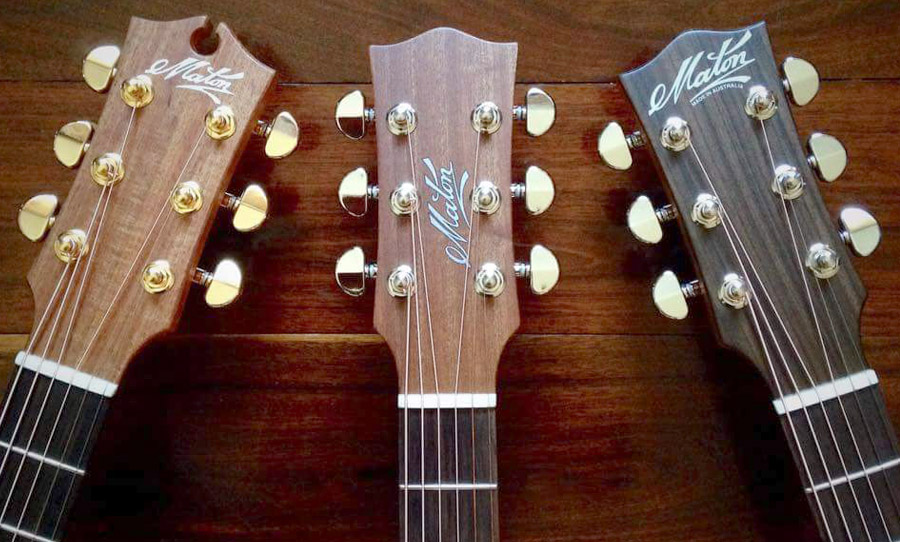Maton is a household name, but there’s so much more to this Australian company. From humble beginnings to a juggernaut, let’s dive into the world of Maton.
Maton guitars have established themselves on stages around the world, which is a testament to their broad-ranging appeal. For a backyard company that began in 1946 in Melbourne, Victoria, Maton has grown organically into a world-famous, critically acclaimed guitar manufacturer.
Maton guitars find their way into the hands of virtuosos like Tommy Emmanuel, Eric Johnston, but are just as at home with songwriters like Paul Kelly, Courtney Barnett, and rock gods like Josh Homme and Jesse Devil Hughes. Let’s have a look at the history of Maton, rarities from the vault, and why guitarists will be playing Matons for many years to come.

May + Tone = Maton
In the 1940s, Melbourne-born musician and woodwork teacher Bill May started a custom guitar manufacturing and repair business. It wasn’t long before Bill had to convince and hire his brother to make guitars full time with him. March 1946 saw the official launch of the Maton Musical Instruments Company, with a factory opening in 1949. Nowadays, they operate from a custom-built, state of the art, climate-controlled factory in Box Hill, a suburb of Melbourne.
Maton’s story is a wholesome one. It’s still a family-run outfit, with Bill May’s daughter Linda and her Husband Neville running the company since Bill’s passing in 1993, with over 70 employees on its books. Yet, regardless of the international attention and huge growth, Maton maintains a personal touch.
The Powerhouse Museum in Sydney currently has an exhibition until the 2nd of May 2021 of over 130 guitars from the very first guitar ever made (an archtop style ‘Jazz Box’) through to electric guitars and basses, lap steels, signature models, amplifiers and a 12-string electric guitar used by Harry Vanda of The Easybeats on the song Land of the Make Believe.
Homegrown materials
Key to the company’s identity and its subsequent success, it sources exclusively from sustainable Australian timbers such as; Bunya, Victorian Blackwood, Queensland Maple and Walnut, Sitka Spruce and Western Red Cedar, you’ll find even the entry-level SRS (Solid Road Series) has Tasmanian Blackwood and A grade Sitka Spruce.
The Messiah Series represents the pinnacle of Maton’s luthiery. It’s constructed with AAA Grade Sitka Spruce and given voice on the big stage with Maton’s own AP5 Pro pickup system, which includes a separate microphone (on an adjustable arm) and piezo blend. On the Maton website, you can find the virtuoso Eric Johnson saying that “The AP5 pro is my favourite amplifying system for acoustic guitar. It is very realistic and usable at higher levels onstage”.
Another classic Maton acoustic is the EBG808 series with their smaller body shape. Invented in 1978 for a focus on the recording studio, you’ll find these across stages as well due to the size and focused projection. The EBG808 Nashville is Keith Urban‘s choice for acoustic guitar.
Not just acoustic guitars
Whilst Maton is widely known for its acoustic guitars the company has trialled lots of different instrument types and amplifiers over the years. 1963 saw them produce a wild, futuristic-looking guitar called the Ibis. A little more classy-looking is the hollow-bodied, Queensland maple, signature model from Queens of the Stone Age founding member Josh Homme. The classic Mastersound electric guitar, first introduced in 1958, was used by George Harrison, Tommy Emmanuel and The Wiggles.
Maton amplifiers were made from the 1950s to the 1970s in unique and varied designs to match with guitars. Some had a ‘TV’ style, some had a ‘Radio’ design, and there’s even a Stradivarius Special Amplifier. Whilst they are not on the top of the list of revered guitar amps, they are as rare as the proverbial hen’s teeth and look mighty cool!

John, Paul, George, and Elvis
Australian musician John Butler shreds on his 12-string Maton acoustic through a Marshall stack. Iconic Australian songwriter Paul Kelly performs and writes his classics on Maton guitars. George Harrison used a Maton Mastersound MS500 in 1963 and it sold at auction in 2015 for $485K USD and Elvis Presley can be seen performing in his 1957 film Jailhouse Rock using a Maton Hillbilly acoustic flat top, named an HG100.
Aside from these musical legends, the artist endorsed list of Maton users is a credit to the craftsmanship of their instruments. To think that virtuoso guitarist Tommy Emmanuel purchased his first Maton in 1959 (Mastersound MS500M) and still uses them to this day. Tash Sultana and Budjerah — relative newcomers to the scene — also famously favour this 75-year-old brand. The quality of the instruments engenders loyalty but continues to attract new generations of guitarist.

Bold experiments
If you do find yourself in Sydney and able to go to the exhibition at the Powerhouse Museum, you’ll see that Maton really did experiment a lot with different shapes and sizes, especially throughout the 1960s and especially in electric guitars. There’s a ‘Lute’ teardrop style guitar and bass, ‘El Toro’ longhorn, many stretched Stratocaster styles, and more. Maton also dabbled in the baritone guitar fashion of the early 60s with their V400 Vampyr.
Being a jazz guitarist, Bill May design and manufactured some beautiful archtop guitars. The Starline archtop was Maton’s flagship model released in 1954, to which a 60th-anniversary model, The Starline 4606, was made in as a limited edition run of 60 only. These are beautifully designed and aesthetically pleasing instruments, so much so that Australian Jazz Great George Golla had his own model made in 1967 with the GG22 Starline.
Maton guitars have continued to grow organically, experimented with design and products, stayed in the family, and have maintained a commitment to excellence. A brand name and a tonal character that emanated from the Melbourne factory has been sought after, all over the world, for several decades. Considering the fact that the company is 75 years old — and still approaches guitar building with the same passion as it did on its first day — it’s safe to say that we’ll be seeing the Maton name in lights for decades to come.



